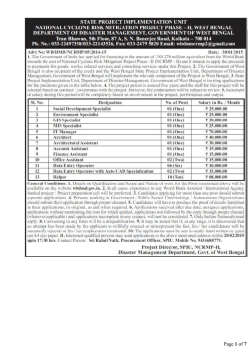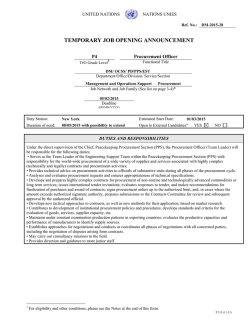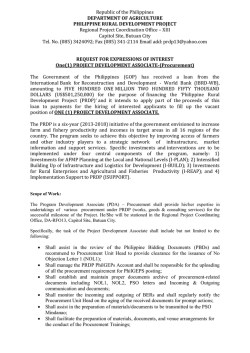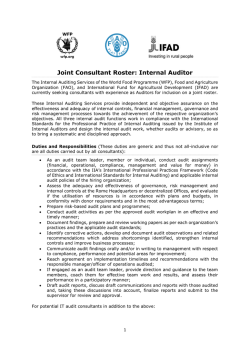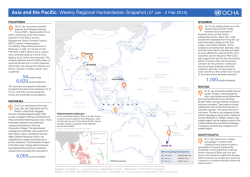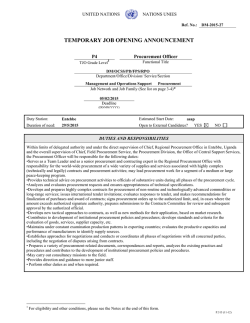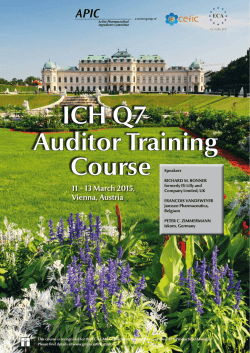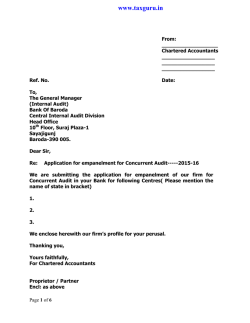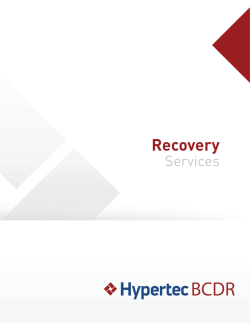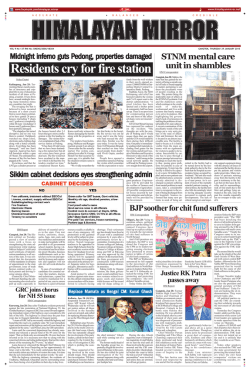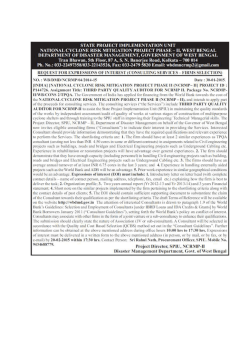
Package No. NCRMP-II/WB/CONS 1/IA
Terms of Reference for Internal Auditor (Package No. NCRMP-II/WB/CONS 1/IA) STATE PROJECT IMPLEMENTATION UNIT NATIONAL CYCLONE RISK MITIGATION PROJECT PHASE II, WEST BENGAL DEPARTMENT OF DISASTER MANAGEMENT GOVERNMENT OF WEST BENGAL Tran Bhawan, 5th Floor, 87 A, S. N. Banerjee Road, Kolkata 700 014 Ph. No.: 033-22497358/033-22143526, Fax: 033-2479 5820 Email: [email protected] Terms of Reference for Internal Auditor National Cyclone Risk Mitigation Project 1. Project Background • The Government of India has initiated a number of initiatives to reconcile the aims of protection of life and livelihood of coastal communities; conservation of ecological resources in the coastal and marine areas; and, promotion of economic activities that have necessarily to be located in the coastal regions. As one of the different initiatives, the Government of India along with the respective State Governments is implementing a World Bank financed project called the “National Cyclone Risk Mitigation Project” (NCRMP-II). The Project has specific objectives to support the long-term vision of the Government by (a) building national capacity for implementation of National Cyclone Risk Mitigation Project approach in the country, and (b) piloting the approach in the states of Gujarat, Orissa and West Bengal. The National Component of the Project focuses on expanding the institutional capacity and knowledge base needed for National Cyclone Risk Mitigation Project. The State Components include capacity building at the state level, preparation of National Cyclone Risk Mitigation Project.plans, and a range of complementary local pilot investments. • The coastal districts of West Bengal are vulnerable to severe cyclonic storms. South 24 Parganas, North 24 Parganas and Purba Medinipur experience frequent tropical cyclones, having disastrous consequences on the lives of human beings as well as animal population of the region. It must be mentioned here that the vulnerability due to cyclones cannot be determined solely by its frequency of occurrence, the vulnerability depends on associated storm surge, coastal inundation or flooding and socio economy of the affected region. • The Sundarban Delta Complex which has geo-genetic link to the tectonic Bengal Basin known for its startling coastal landforms that include back dunal mudflats, back swamps, saltmarshes and tidal creeks enshrouded with mangrove vegetation, low gradient supratidal and intertidal shores with mud bank, swales and berms, rivulets, tidal flats etc. However despite the mind boggling floral and faunal diversity Sundarban is very much vulnerable to natural hazards e.g. storm surge, flood, tidal wave, cyclone etc. Moreover due to rising sea level, the existing coastline is retreating at alarming rate which is symptomatic to some impending natural catastrophes. The inhabitants of the Sundarban estuary probably have acclimatized themselves how to live on facing the nature’s wrath. Sundarban is still recuperating from the brunt of Cyclone Aila that devastated thousands of hectares of once fertile agricultural land adjoining the mangrove forests into a wasteland. The loss of human life and property is beyond any estimation in real terms. The aftermath of these kinds of cyclones and storm surges is on the livelihood of the people at large as due to the ingress of saline sea water into the lush green fertile fields used for paddy cultivation, these tracts of land rendered useless for any kind of agricultural activities. • The NCRM Project understands that fructification of the project can be done only when the people living on the vulnerable coastal zones can be safeguarded to a certain extent from the natural calamities like flood, cyclone, hail storm, thunder squall and sometimes even to tsunamis that occurred due to geo-morphological, climatic and seismic conditions. • After the enactment of Disaster Management Act, 2005, there has been a major shift in the disaster management strategy of this State Government from a relief centric response to a composite approach based on preparedness, prevention & mitigation. • Department of Disaster Management, Government of West Bengal (DoDM) has been entrusted with the construction, operation and maintenance of the proposed 150 nos. of Multi-Purpose Cyclone Shelters (MPCS) as envisaged in the NCRM Project. The estimated cost of the project is around 577 crores. Department of Disaster Management has been assigned this project component because it plays a pioneering role in establishing necessary systems, structures, programs, resources, capabilities for reducing disaster risks in the State in order to save human lives and property, avoid disruption of economic activity and damage to environment and also to ensure the continuity and sustainability of development. The construction of MPCS will not only pave the way for increase the communities resilience during calamity, but also opening avenue for social coordination and enhanced the capacity to shoulder responsibility by operating the shelters in a gainful pro-social way. • • The MPCS has a multi–pronged approach in catering to the needs especially of the disadvantaged sections of the populace through a string of activities such as:Minimization of loss of lives, property and livestock by providing it shelters during cyclone calamity MPCSs will act nodal points for receipt and dissemination of cyclone warnings MPCSs will provide the warehousing facilities of essential stocks/ items for post disaster usage The nodal points for carrying out post disaster response and relief activities will be from MPCSs MPCSs will also provide temporary protection from the heavy downpour during the monsoon and also from the scorching heat during the summer to the shelter less people. (f) Basic health services like immunization programmes can be administered through these MPCSs (g) MPCSs will act as models for safe construction in vulnerable seismic zones. (a) (b) (c) (d) (e) 2. The key objectives of the Project are as follows: • Reduction in cyclone vulnerability of coastal states, through creation of appropriate infrastructure which can help mitigate the adverse impacts of cyclones • Strengthening of cyclone warning systems enabling quick dissemination of warnings and advisories from source/district/sub-district level to the community and vice versa for their timely reception and adequate response. 3. Project Components Based on the above objectives, the Project has been divided into five components, namely: • Component A – Early warning dissemination system. • Component B – Cyclone Risk Mitigation Infrastructure – cyclone shelters, evacuation routes and bridges, coastal embankments, underground electrical network, etc. • Component C - Technical assistance for disaster risk management capacity augmentation. • Component D – Project Management and Implementation support. • Component E- Strengthening and understanding Multi-hazard risk management. This term of reference pertains to appointment of Internal Auditor for NCRMP-II in the state of West Bengal. 4. Proposed Implementation/ Funds Flow Arrangements: The NCRMP shall be coordinated by a central Project Management Unit (PMU) set up at NDMA. Department of Disaster Management, Government of West Bengal is the State Project Implementation Unit (SPIU). The SPIU will coordinate with NDMA, MHA, World Bank, CAAA and other external agencies involved. The Department of Disaster Management, Government of West Bengal will coordinate with the line department, i.e., PWD of the State Government which will be finally responsible for execution of Civil works under the Project. Rest works under the project will be implemented by the Department of Disaster Management, Government of West Bengal. The Project is assisted by the World Bank. The external aid disbursed by the World Bank will be first received by the Central Government in the Ministry of Finance (MoF). In the case of WB state, the funds would be routed through the regular Treasury mechanism. Expenditure under the Project will either be made centrally at the SPIU through Treasury System and / or through Separate Bank Account opened exclusively for this purpose. SPIU making payments will maintain regular books of account and records as per the prescribed procedures. 5. Objectiveof the Internal Audit • The objective of the internal audit is to determine whether the Project management arrangements including procurement, financial management, physical progress monitoring and internal control mechanisms • • are working effectively. The auditor shall also identify areas for improvement and enhancing efficiency. This should include aspects such as adequacy and effectiveness of accounting, financial, procurement related and other operational controls, and any needs for revision; level of compliance with established policies, plans and procedures; reliability of accounting systems, data and financial reports; methods of remedying weak controls or creating them where there are none; verification of assets and liabilities; and integrity, controls, security and effectiveness of the operation of the computerized system. The internal auditor shall provide the SPIU with timely information and recommendations on the financial management, procurement, project management and physical progress aspects of the Project to enable the management to take corrective measures, wherever necessary. 6. Scope of Audit Services The audit will be carried out in accordance with applicable professional standards & will include such tests & controls, as auditors consider necessary under the circumstances. In conducting the audit special attention should be paid to the following: A. Procurement • Whether goods, works and services are being procured following the procurement procedures defined for the Project (Project Guidelines and the guidelines internal to SPIU) • Whether goods, works and services are being procured in accordance with the procurement plan and sanctioned budgets • Whether time schedule for procurement of goods, works and services is in line with the Project Procurement Plan • Whether required documentation for procurement activity and contract management is being maintained for all purchases made. • Whether capacities for procurement as indicated in the operations manual have been created B. Financial Management • Whether books of accounts are being maintained in the manner and formats defined by the Financial Management Manual of the Project • Whether the financial transactions are being accurately and completely recorded • Whether utilization certificates and FMRs submitted are prepared in time and reflect the correct status of utilization of funds as recorded in the books of accounts of the Project • Whether the fund management is being done in compliance with Financial management guidelines of the Project • Whether funds have been used with due regard to economy, efficiency and for the purposes they were provided. • Whether release of money is adequately supported. • Special emphasis may be laid on items like : ◦ Timely and accurate preparation of Bank Reconciliation Statements ◦ Maintenance of separate accounts for NCRMP ◦ ◦ ◦ ◦ Timely and accurate preparation of financial reporting statements Surplus funds lying unutilized for long Financial records and registers being maintained Disbursement of funds to the third parties • Understand the process of tagging and maintenance of assets acquired under the Project. • The auditors may perform physical verification of assets (if considered necessary) • Whether capacities for financial management as indicated in the operations manual have been created C. Project Management • • • D. Whether the physical progress tracking mechanism defined for the Project has been operationalised. Whether physical progress reports being submitted have been reviewed for their correctness and authenticity before submission Whether physical progress reports are being submitted as per the timelines and formats defined by the Project tracking framework Others • • • Whether appropriate internal controls as specified by the Financial Management Manual, Operations Manual, Procurement Manual and other relevant notifications, if any, are operating satisfactorily. The auditor should suggest methods for improving weak controls or creating them where need be. Verifying compliance with recommendations of the earlier audit reports and commenting thereon Deviations (if any) from Project guidelines have been reported to the PMU in time and requisite approvals obtained 4. Reporting The Internal audit shall provide the reports with the following frequency: 1. Audit report within 2 weeks of the closure of fieldwork to the Project Director 2. Quarterly summary of audit findings and recommendations 5. Support/Inputs to be provided by the SPIU The internal auditor will be given access to all legal documents, Project Financial Management Manual, Procurement Manual, procurement check list, and any other unclassified information associated with the Project and deemed necessary by the auditor. It is extremely important that the auditors become familiar with the Project Guidelines on Disbursements and Procurements. All these documents will be provided to the auditor by the SPIU.
© Copyright 2025
